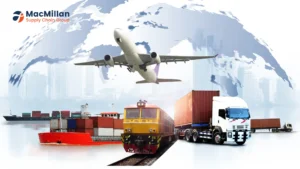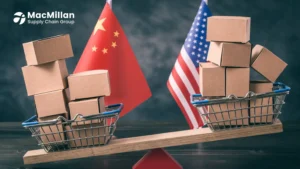Are your outbound shipping costs cutting into your 3PL’s profits? In this article, we’ll explore five key factors impacting your shipping expenses in your Canadian 3pl warehouse and offer practical strategies to help you lower them. From optimizing delivery speed to managing special handling fees, we’ll provide valuable insights to help you make informed operational decisions that save both time and money.
Factor 1: Weight and Shipping Zones
When shipping domestically within the US or including Canadian 3pl warehouses, two primary elements affect your costs: the destination zone and the weight of the package.
Destination Zone
Shipping carriers divide the area into the given zones, starting with Zone 1 at the origin point. As your package travels further from its starting point, the shipping fees rise. Here’s a breakdown of the zones and their respective mileage ranges:
- Zone 1: 1-50 miles
- Zone 2: 51-150 miles
- Zone 3: 151-300 miles
- Zone 4: 301-600 miles
- Zone 5: 601-1000 miles
- Zone 6: 1001-1400 miles
- Zone 7: 1401-1800 miles
Weight
The weight of your package directly affects shipping costs: heavier packages incur higher fees. However, weight isn’t the sole factor; the dimensions of your package are also crucial. While MacMillan offers transparent fees with no hidden charges.
Finding the right balance between a package’s size and weight can help you avoid DIM weight surcharges, which are applied to larger but lighter packages. Investing in an efficient packaging design can help you optimize the size and weight of your packages, ultimately reducing unnecessary shipping expenses and boosting your Canadian 3pl warehouse operations.
Shipping Calculators by Carrier:
- USPS: Shipping Calculator
- Canada Post: Shipping Calculator
- FedEx: Shipping Calculator
- UPS: Shipping Calculator
International Shipping
Don’t miss out on duty relief programs like Section 321. This provision can reduce your duty fees by up to 20%, offering significant savings. MacMillan Section 321, part of the Trade Facilitation and Trade Enforcement Act, simplifies shipping from Canada or Mexico to the U.S. for individual customers by providing tax and duty exemptions, quicker clearance, and less paperwork. For goods valued at $800 USD or less per person per day, Section 321 offers an excellent opportunity to cut costs and expand your market in the U.S. While some product restrictions apply, the benefits are substantial for businesses aiming to reach American consumers.
Factor 2 : Delivery Speed
With the rapid growth of eCommerce, fast delivery is crucial for meeting customer expectations. MacMillan has learned that while customers generally expect two-day delivery from Amazon, they are usually okay with three to four days from other businesses, as long as real-time tracking is provided. To address these needs and maintain profitability, balancing cost and delivery speed is key.
90% of customers want immediate updates, and 32% will abandon their carts if shipping times are too long, pushing 3PLs and carriers to update their distribution models.
Fulfillment Trends
Micro-fulfillment centers are a solution for faster delivery, strategically located in urban areas and stocked with high-demand items. Though setting up MCFs can be costly, they lower shipping expenses and enhance efficiency, benefiting companies that implement them.
Last Mile Delivery
Last-mile delivery constitutes 53% of shipping costs, making it critical for customer satisfaction and profitability. Challenges in this area are significant, but partnering with efficient services like Veho can improve delivery performance and reduce costs.
Factor 3 : Warehouse Teams and the Packing Process
Efficiency in a Canadian 3PL warehouse hinges on the effectiveness of your packing team. Here are key considerations for optimizing your operations:
- Training Investment Ensure your team is well-trained in SOPs, equipment use, inventory management, and customer order systems. Proper training reduces turnover and enhances productivity, ultimately boosting profits.
- Packing Station Efficiency Regularly evaluate your packing station to find areas for improvement. Implement one-touch stations and ergonomic designs to streamline workflow, cut labor costs, and reduce errors.
- Optimizing Picking Paths Efficient picking paths can significantly improve profit margins. Slow picking increases costs, which can lead to higher prices for customers. Streamline picking processes to enhance efficiency.
- Automation Utilization While a 95-98% order accuracy rate is standard, aiming for near 100% is ideal. However, MacMillan offers a zero percent error rate. Automation helps reduce errors and improves inventory control, saving money by minimizing mistakes
- Data Analysis Measure and analyze key performance indicators (KPIs) to identify inefficiencies and reduce expenses. Tracking data from receiving to shipping provides a comprehensive view of your warehouse operations, aiding in operational improvements.
Key Performance Indicators (KPIs) to Monitor:
- Inventory Days of Supply (DSI): Measures the average number of days it takes to turn inventory into sales, including work-in-progress items.
- Parcel Bill Accuracy: Regularly check your parcel bills for accuracy to prevent overcharges. Detailed bills can aid in negotiating better shipping contracts.
- Receiving Efficiency: Calculates how efficiently your receiving area operates, measured by the volume of inventory received per hour worked. For example, 2000 goods received by two employees working 40 hours each translates to 25 goods per hour.
- Order Picking Accuracy: Essential for ensuring orders are filled correctly. High accuracy prevents costly mistakes and maintains customer satisfaction.
- Warehouse Capacity Utilization: Efficient use of warehouse space is crucial. Ideal utilization is around 80%. Calculate usable space by measuring total square footage, subtracting unusable areas, and multiplying by clearance height to determine usable volume.
Factor 4 : Special Handling Fees
Handling fees for hazardous and fragile items have both pros and cons:
Hazmat:
- Revenue Generation: Special handling fees for hazardous materials help cover safety costs and boost profitability.
- Risk Management: To ensure safe transport, charge fees, conduct inspections, and employ trained staff.
- Competitive Advantage: Expertise in handling hazardous items can position a shipping company as an industry leader, attracting customers seeking specialized services.
- Fragile Items:
- Reputation: Damaged items can harm your reputation and bottom line. Ensure careful handling by using a special projects team to pre-assemble or kit items for safer transport.
Factor 5 : Surcharges in Canadian 3PL Warehouse
Surcharges can impact your shipping costs significantly. Key points to manage them include:
- Understanding Charges: Be aware of all surcharges, including those for specialized services, to avoid unexpected costs.
- Negotiation: Start with competitive base rates and analyze accessorial charges to select the best options.
- Cost Management: General rate increases can affect base rates. Use shipping cost strategies, analyze expenses, and plan proactively to minimize surcharges and control shipping costs.
How to Reduce Shipping Charges?
Size and Weight: Minimize shipping costs by optimizing parcel size and weight. Avoid oversized boxes and improper packaging to prevent higher fees. Choose carriers that offer flat-rate shipping or fees that align with your needs. Be mindful of dimensional weight pricing, which can increase costs for lightweight packages that occupy significant space.
Team Training: Effective Canadian 3PL warehouse operations can cut shipping costs. Invest in thorough training for your packing team on using warehouse management systems (WMS) like MacMillan uses. Proper training ensures consistent, efficient packing practices and reduces unnecessary expenses.
Equipment: Address internal errors by ensuring accurate scales and well-stocked packing stations. Implement automation rules to standardize box usage, minimizing touchpoints and improving efficiency.
Automation: Leverage automation to reduce shipping costs:
- VIP Rule: Provide special treatment to top customers with gifts, express shipping, and prioritized processing.
- Pre-Sale Flag: Save on shipping by setting flags for orders over a specific amount.
- SKU-Specific Notes: Assign handling instructions for fragile items.
- Box Type Automation: Streamline packing by automating box selections.
Impact on 3PL Profitability
To maintain profitability, consider factors like destination, delivery speed, 3PL warehouse processes, special handling fees, and surcharges. Use tools and strategies to manage these aspects effectively, such as reducing delivery speeds or minimizing surcharge risks. Invest in efficient outbound shipping systems to see long-term savings. Start with a MacMillan demo to improve shipping efficiency.
Key Takeaways
- Shipping costs are influenced by weight, dimensions, and distance.
- Duty relief programs like Section 321 can reduce international duty fees by up to 20%.
- Address last-mile delivery challenges with efficient partners like Veho.
Faster delivery increases costs; local fulfillment centers and streamlined processes can help mitigate these expenses.



